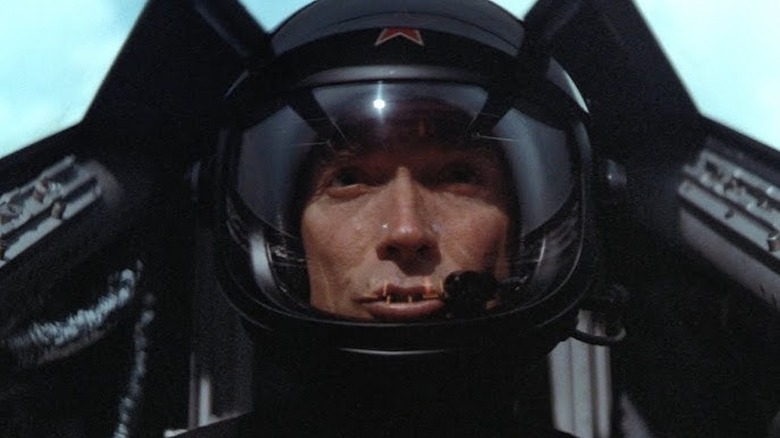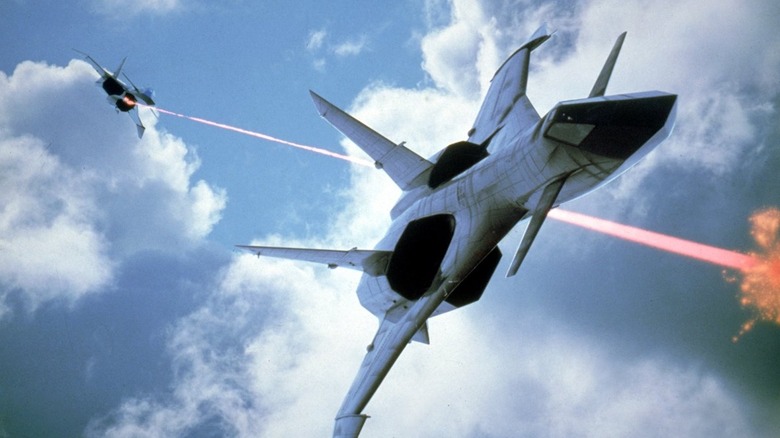A Forgotten Clint Eastwood Cold War Movie Is A Must-Watch For Top Gun Fans
Clint Eastwood turned 52 in 1982, but, as far as American moviegoers were concerned, he'd only been a movie star for 15 years (which is when all three chapters of the "Dollars Trilogy" were theatrically released in the United States). And though his "Dirty Harry" movies were viewed as politically conservative, he was still largely viewed as a revolutionary figure in film. His Westerns were revisionist and, for the time, incredibly violent; his cop flicks were unapologetically R-rated and, with "Every Which Way But Loose" and "Any Which Way You Can," he had every kid in the country wishing they could have a beer-swilling, bird-flipping orangutan as their best friend.
Throughout his career, Clint Eastwood has taken note of what kinds of movies are connecting with viewers and sought to place his own personal spin on them. He responded to the buddy-cop phenomenon of the 1980s with the the big-budget quasi-spoof "The Rookie" (one of his worst movies), mused on the glut of World War II movies with the richly textured duo of "Flags of Our Fathers" and "Letters from Iwo Jima" and, at the age of 94, worked a sneakily subversive riff on the legal thriller with "Juror #2." He isn't out to show his peers how it's done à la Steven Spielberg or James Cameron. He just wants to show how Clint does it. And that's often more than good enough for moviegoers.
So when Eastwood noticed Hollywood had been knocking out blockbusters loaded with groundbreaking visual FX after the watershed event that was "Star Wars," he moved forward on a pricey spy thriller with a bluescreen-enabled optical spectacle that, in its way, presaged the box office success of "Top Gun."
Clint Eastwood revolutionized action movies and video games with Firefox
Based on a novel by Craig Thomas, "Firefox" was Eastwood scratching the espionage itch he'd worked at with 1975's "The Eiger Sanction." Set amid the then ongoing Cold War, Eastwood directed himself as a veteran fighter pilot tasked with stealing a prototype Soviet MiG capable of Mach 6 speed and, in what felt like preposterous science fiction at the time, capable of being powered by thought. Such a craft could swing the balance of air power in the Soviet Union's favor.
Released during the magical movie summer of 1982, "Firefox" managed to be more of a must-see event than "Blade Runner" or "The Thing" due to the heavily promoted optical FX created by the motion-control maestro who made "Star Wars" possible, John Dykstra. Dykstra lived on the bleeding edge of special effects and pioneered a reverse bluescreen technology that made the aerial sequences look photorealistic for the time. Warner Bros. knew they had something special with the exhilarating hypersonic dogfights, so they commissioned Atari to make a laserdisc arcade game that gave players the invigorating feeling of piloting the titular aircraft. It was a 50-cent play at a time when a single quarter was the norm, and it was worth it until you realized it was super glitchy and virtually unplayable.
Nevertheless, "Firefox" got a generation of kids dreaming about being hotshot fighter pilots, and those dreams turned into recruitment fodder four years later with Tony Scott's "Top Gun." That film was a much bigger hit than "Firefox," but it's not a stretch to say that Eastwood's film (which made a respectable $47 million against a $21 million budget) made it commercially viable. Clint knows. He always knows.

